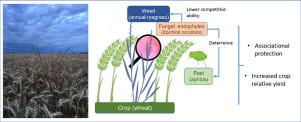当前位置:
X-MOL 学术
›
Basic Appl. Ecol.
›
论文详情
Our official English website, www.x-mol.net, welcomes your
feedback! (Note: you will need to create a separate account there.)
A fungal endophyte of an annual weed reduces host competitive ability and confers associational protection to wheat
Basic and Applied Ecology ( IF 3.0 ) Pub Date : 2021-02-01 , DOI: 10.1016/j.baae.2020.10.001 Pablo Adrián García-Parisi , Sebastián Aníbal Gavilán , Cecilia Casas , Pedro Emilio Gundel , Marina Omacini
Basic and Applied Ecology ( IF 3.0 ) Pub Date : 2021-02-01 , DOI: 10.1016/j.baae.2020.10.001 Pablo Adrián García-Parisi , Sebastián Aníbal Gavilán , Cecilia Casas , Pedro Emilio Gundel , Marina Omacini

|
Abstract Epichloid fungal endophytes (Epichloe spp., Ascomycota: Clavicipitaceae) inhabit aerial tissues of several cool-season grasses, and enhance host growth and defence against herbivores. The presence of these symbionts can also affect interactions between the host and other non-epichloid plants. The role of an epichloid endophyte on interspecific competition has been tested using perennial grasses with contrasting results, but it has been scarcely tested using annual species in agroecosystems. We evaluated the impact of Epichloe-grass symbiosis on the competitive interaction between a non-host cereal crop (Triticum aestivum, wheat) and a host weed (Lolium multiflorum, ryegrass), growing in the presence of invertebrate herbivores (aphids) under no resource limitation. We conducted an outdoor mesocosm experiment with wheat plants growing in monoculture or in mixture with low or high proportions of ryegrass plants. Ryegrass plants presented either low (E-) or high (E+) incidence of Epichloe occultans (i.e. frequency of epichloid endophytic plants). We measured wheat vegetative and reproductive yield and its natural aphid infestation. Although epichloid endophyte incidence did not affect ryegrass biomass, wheat reproductive yield in mixtures (relative to wheat monocultures) was 45% higher when grown with E+ ryegrass plants than E- conspecific plants. Aphids preferred wheat plants grown with E- plants rather than wheat plants grown with E+ plants, but only in mixtures with high proportion of ryegrass. Our results demonstrate that epichloid endophyte incidence can decrease host competitive ability and confers associational protection to the non-endophytic neighbouring plants. Thus, ryegrass-endophyte symbiosis can increase crop yield by positive neighbourhood effects through different mechanisms probably related to the density of the weed. The benefits of this endosymbiont cannot be considered host-exclusive since they can be disseminated to non-endophytic plants. Furthermore, our results suggest that the epichloid endophyte incidence on annual weeds can contribute to agroecosystem sustainability by influencing pest management and increasing crop yield.
中文翻译:

一年生杂草的真菌内生菌降低宿主竞争能力并赋予小麦联合保护
摘要 Epichloid 真菌内生菌(Epichloe spp., Ascomycota: Clavicipitaceae)栖息在几种冷季草的气生组织中,增强宿主的生长和对食草动物的防御。这些共生体的存在也会影响宿主和其他非表皮植物之间的相互作用。已经使用多年生草测试了表皮内生菌对种间竞争的作用,结果却相反,但几乎没有使用农业生态系统中的一年生物种进行测试。我们评估了 Epichloe-grass 共生对非寄主谷类作物(Triticum aestivum、小麦)和寄主杂草(Lolium multiflorum、黑麦草)之间竞争相互作用的影响,这些杂草在没有资源的无脊椎动物食草动物(蚜虫)存在下生长局限性。我们对单一栽培或与低或高比例黑麦草植物混合生长的小麦植物进行了户外中观实验。黑麦草植物表现出低 (E-) 或高 (E+) Epichloe occultans 的发生率(即表皮内生植物的频率)。我们测量了小麦的营养和繁殖产量及其自然蚜虫侵扰。尽管表皮内生菌发生率不影响黑麦草生物量,但当用 E+ 黑麦草植物生长时,混合小麦的繁殖产量(相对于小麦单一栽培)比 E- 同种植物高 45%。蚜虫更喜欢用 E- 植物种植的小麦植物,而不是用 E+ 植物种植的小麦植物,但仅限于与高比例黑麦草的混合物。我们的研究结果表明,表皮内生植物的发生率会降低宿主的竞争能力,并为非内生植物邻近植物提供联合保护。因此,黑麦草-内生菌共生可以通过可能与杂草密度相关的不同机制通过积极的邻里效应增加作物产量。这种内共生体的好处不能被认为是宿主独有的,因为它们可以传播到非内生植物。此外,我们的研究结果表明,一年生杂草上的表皮内生菌发生率可以通过影响害虫管理和增加作物产量来促进农业生态系统的可持续性。黑麦草-内生菌共生可以通过可能与杂草密度相关的不同机制产生积极的邻里效应,从而提高作物产量。这种内共生体的好处不能被认为是宿主独有的,因为它们可以传播到非内生植物。此外,我们的研究结果表明,一年生杂草上的表皮内生菌发生率可以通过影响害虫管理和增加作物产量来促进农业生态系统的可持续性。黑麦草-内生菌共生可以通过可能与杂草密度相关的不同机制产生积极的邻里效应,从而提高作物产量。这种内共生体的好处不能被认为是宿主独有的,因为它们可以传播到非内生植物。此外,我们的研究结果表明,一年生杂草上的表皮内生菌发生率可以通过影响害虫管理和增加作物产量来促进农业生态系统的可持续性。
更新日期:2021-02-01
中文翻译:

一年生杂草的真菌内生菌降低宿主竞争能力并赋予小麦联合保护
摘要 Epichloid 真菌内生菌(Epichloe spp., Ascomycota: Clavicipitaceae)栖息在几种冷季草的气生组织中,增强宿主的生长和对食草动物的防御。这些共生体的存在也会影响宿主和其他非表皮植物之间的相互作用。已经使用多年生草测试了表皮内生菌对种间竞争的作用,结果却相反,但几乎没有使用农业生态系统中的一年生物种进行测试。我们评估了 Epichloe-grass 共生对非寄主谷类作物(Triticum aestivum、小麦)和寄主杂草(Lolium multiflorum、黑麦草)之间竞争相互作用的影响,这些杂草在没有资源的无脊椎动物食草动物(蚜虫)存在下生长局限性。我们对单一栽培或与低或高比例黑麦草植物混合生长的小麦植物进行了户外中观实验。黑麦草植物表现出低 (E-) 或高 (E+) Epichloe occultans 的发生率(即表皮内生植物的频率)。我们测量了小麦的营养和繁殖产量及其自然蚜虫侵扰。尽管表皮内生菌发生率不影响黑麦草生物量,但当用 E+ 黑麦草植物生长时,混合小麦的繁殖产量(相对于小麦单一栽培)比 E- 同种植物高 45%。蚜虫更喜欢用 E- 植物种植的小麦植物,而不是用 E+ 植物种植的小麦植物,但仅限于与高比例黑麦草的混合物。我们的研究结果表明,表皮内生植物的发生率会降低宿主的竞争能力,并为非内生植物邻近植物提供联合保护。因此,黑麦草-内生菌共生可以通过可能与杂草密度相关的不同机制通过积极的邻里效应增加作物产量。这种内共生体的好处不能被认为是宿主独有的,因为它们可以传播到非内生植物。此外,我们的研究结果表明,一年生杂草上的表皮内生菌发生率可以通过影响害虫管理和增加作物产量来促进农业生态系统的可持续性。黑麦草-内生菌共生可以通过可能与杂草密度相关的不同机制产生积极的邻里效应,从而提高作物产量。这种内共生体的好处不能被认为是宿主独有的,因为它们可以传播到非内生植物。此外,我们的研究结果表明,一年生杂草上的表皮内生菌发生率可以通过影响害虫管理和增加作物产量来促进农业生态系统的可持续性。黑麦草-内生菌共生可以通过可能与杂草密度相关的不同机制产生积极的邻里效应,从而提高作物产量。这种内共生体的好处不能被认为是宿主独有的,因为它们可以传播到非内生植物。此外,我们的研究结果表明,一年生杂草上的表皮内生菌发生率可以通过影响害虫管理和增加作物产量来促进农业生态系统的可持续性。











































 京公网安备 11010802027423号
京公网安备 11010802027423号